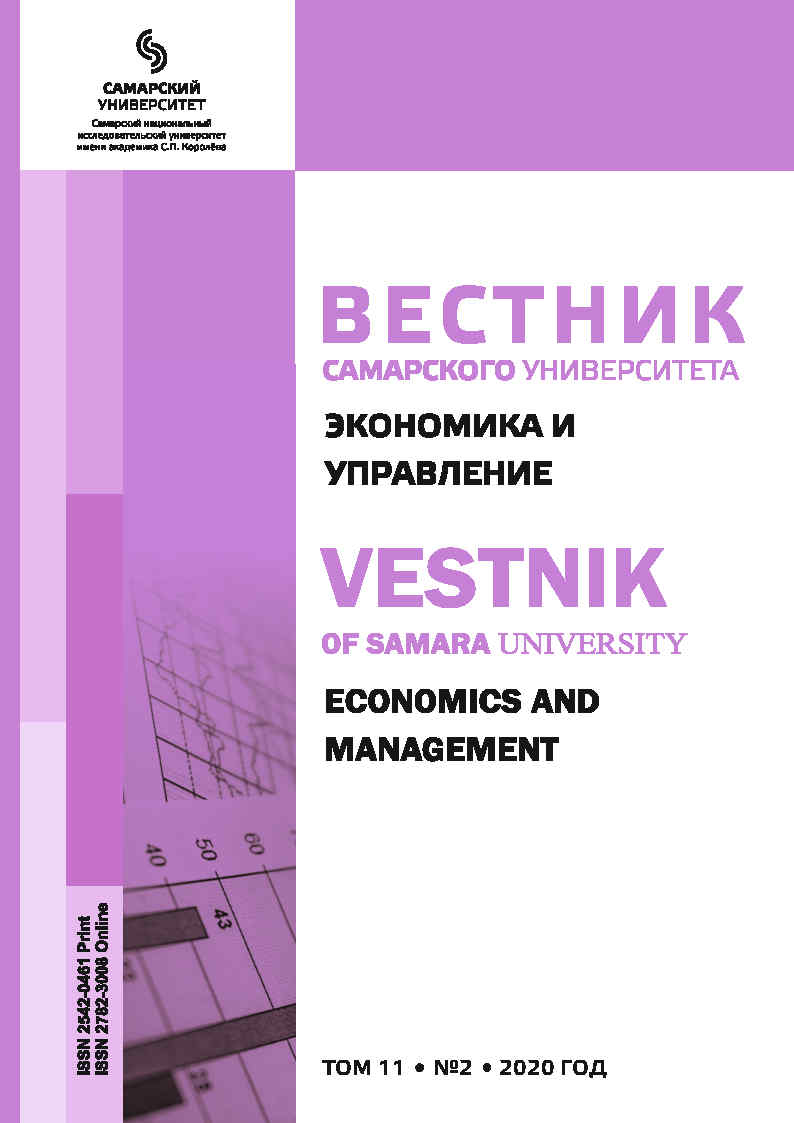ANALYSIS OF THE RELATIONSHIP BETWEEN GRP AND HARMFUL EMISSIONS IN THE VOLGA REGION FEDERAL DISTRICT
- Authors: Rostova E.P.1, Cherepanova E.S.2
-
Affiliations:
- Samara National Research University
- Perm State University
- Issue: Vol 11, No 2 (2020)
- Pages: 151-156
- Section: MATHEMATICAL AND INSTRUMENTAL METHODS OF ECONOMICS
- URL: https://journals.ssau.ru/eco/article/view/7860
- DOI: https://doi.org/10.18287/2542-0461-2020-11-2-151-156
- ID: 7860
Cite item
Full Text
Abstract
The article examines the relationship between the volume of gross regional product and harmful emissions from stationary sources. The research was conducted on the basis of statistical data of the regions of the Volga Region Federal District for 2004–2017, presented in the official statistics of Rosstat. The regions that are leaders in terms of gross regional product and harmful emissions are identified. The correlation coefficient between the studied indicators for the analyzed period is calculated. An uneven distribution of the gross regional product and the volume of harmful emissions from stationary sources was revealed: there are regions with high gross regional product and low emissions, as well as regions with the opposite situation. For the regions of the Volga Region Federal District that have a relationship between the gross regional product and the volume of harmful emissions, a functional dependence is constructed in the form of a power function. These regions include the Republic of Tatarstan, Perm Krai, Orenburg Region, Samara Region, and Saratov Region. It should be noted that only the Republic of Tatarstan has a positive correlation coefficient greater than 0.7. The accuracy characteristics of the obtained functional dependencies indicate that they can be used for forecasting and further research.
About the authors
Elena P. Rostova
Samara National Research University
Author for correspondence.
Email: el_rostova@mail.ru
ORCID iD: 0000-0002-6432-6590
Candidate of Economic Sciences, associate professor, associate professor of the Department of Mathematical Methods in Economics
Russian FederationEkaterina S. Cherepanova
Perm State University
Email: cherepanova_es@rambler.ru
ORCID iD: 0000-0002-8822-9680
Candidate of Sc. Geography, associate professor, Department of Cartography and Geoinformatics
Russian FederationReferences
- Federal State Statistics Service. Available at: www.gks.ru. (In Russ.)
- Sugak E.V., Brazgovka O.V. Investment attractiveness and socio-environmental risks of industrial regions of Siberia. Reshetnev readings, 2018, vol. 2, pp. 66–68. Available at: https://www.elibrary.ru/item.asp?id=
- (In Russ.)
- Sugak E.V., Brazgovka O.V., Belskaya E.N. Environmental risks of the population of the industrial region. Mezhdunarodnyy zhurnal eksperimental'nogo obrazovaniya, 2016, no. 10-2, pp. 225–227. Available at: https://www.elibrary.ru/item.asp?id=26740204. (In Russ.)
- Belskaya E.N., Sugak E.V. Calculating individual risks population of the industrial region. Reshetnev readings, 2016, vol. 2, pp. 288–289. Available at: https://www.elibrary.ru/item.asp?id=28880260. (In Russ.)
- Belskaya E.N., Sugak E.V. Assessment of environmental risks. Reshetnev readings, 2014, vol. 2, pp. 345–346. (In Russ.)
- Kosyakova I.V., Sviridenko D.A. Main problems of implementation of the environmental management system at Russian enterprises. In: Current problems and trends of modern economy: materials of the international research and practical conference, 2017, pp. 621–624. (In Russ.)
- Kosyakova I.V., Astashev Yu.V, Zhilyunov N.Yu. Features of eco-management at industrial enterprises. In: Innovations in science: ways of development: materials of the X All-Russian research and practical conference, 2019, pp. 43–48. Available at: https://www.elibrary.ru/item.asp?id=36985011. (In Russ.)
- Porfiriev B.N., Terentiev N.E. Green Economy Development As Factor of Social and Environmental Transformation of Megacities. Scientific Articles – Institute of Economic Forecasting Russian Academy of Sciences, 2018, vol. 16, pp. 7–31. DOI: https://doi.org/10.29003/m251.sp_ief_ras2018/7-31. (In Russ.)
- Porfiriev B.N., Tulupov A.S. Environmental hazard assessment and forecast of ecomonic damage from industrial accidents. Studies on Russian Economic Development, 2017, vol. 28, no. 6, pp. 600–607. DOI: https://doi.org/10.1134/S1075700717060107.
- Haustov A.P., Redina M.M., Nedostup P., Silaev A. Problems of estimations and management of environmental risks at the thermal power station enterprises. Energy Safety and Energy Security, 2005, no. 6,
- pp. 25–Available at: https://www.elibrary.ru/item.asp?id=12196231. (In Russ.)
- Samadi J., Garbolino E. A new dynamic risk analysis framework for CO2 Capture, Transport and Storage chain. Chemical Engineering Transactions, AIDIC, 2012, vol. 26, pp. 147–152. Available at: https://hal-mines-paristech.archives-ouvertes.fr/hal-00660586/file/Samadi_Garbolino2011.pdf.
- Youssef M.A., Soliman F. The role of critical information in enterprise knowledge management. Industrial management and information systems, no. 103 (7), pp. 484–490. DOI: https://doi.org/https://doi.org/10.1108/
- Kaplan R., Mikes A. Managing risks: a new framework. Harvard Business rev. Boston, 2012, vol. 90, no. 6, pp. 48–60.
Supplementary files









